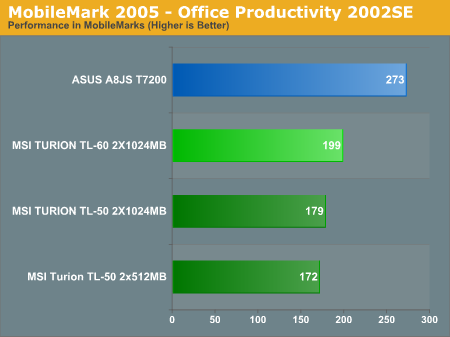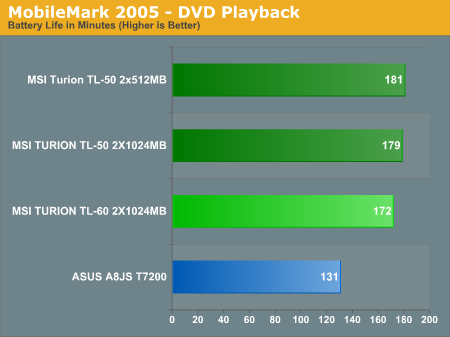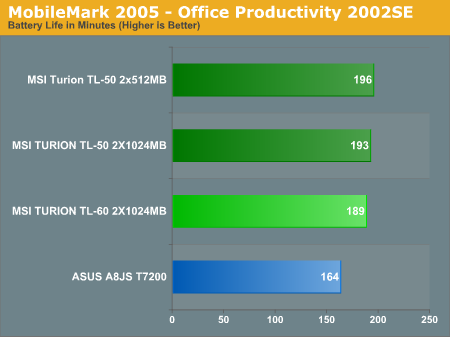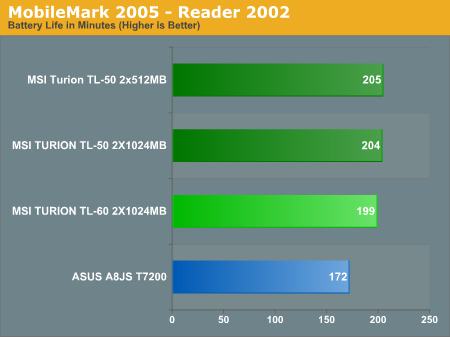MSI Megabook S271: a Look at AMD's Turion X2
by Jarred Walton on October 16, 2006 12:05 AM EST- Posted in
- Laptops
Battery Life
So far, we've talked a lot about performance, but one of the major reasons for getting a laptop is mobility. It's difficult to be truly mobile if you find your battery is constantly going dead, requiring you to find a power outlet so you can plug in and recharge. Thus, battery life becomes an important performance metric for any laptop review. It's also worth mentioning that the smaller size of the MSI notebook is going to appeal to some people that are after a truly thin and light notebook, while others will prefer to have a slightly larger display and keyboard at the cost of a bit more weight. Larger displays also draw more power, and of course the various other components play a role in battery life.
All this is a way of saying that we're comparing battery life and power between two very different laptops, with the only similarity being the amount of memory and processor clock speed. A smaller Core 2 Duo notebook with integrated graphics would almost certainly come with longer battery life. Still, given that both these laptops have the same 4800 mAHr battery size, we can at least see how the two systems compare.




With the exception of office productivity performance, the smaller, slower MSI laptop comes out at the top of our mobility benchmarks. The ASUS notebook may be 37% faster in productivity tasks, but the MSI offers 15% more battery life. When the system is basically idle, which is represented by the Reader benchmark, the MSI system continues to have 15% more battery life. Once we get to DVD playback, things become more interesting, as the MSI offers over 30% more battery life, with just over 2 hours and 40 minutes of playback time. That should be enough to get you through all but the longest DVDs, as well as most continental US flights. Given that the displays are active throughout testing in all of the battery benchmarks, we're not exactly sure why the DVD playback shows such a large discrepancy. It could be that the optical drive on the MSI notebook is simply better at conserving power, or else the MSI system is more efficient when it comes to handling MPEG-2 decoding and video output. Most likely, DVD playback is causing the GeForce Go 7700 GPU in the ASUS system to increase its power use.
If you want longer battery life, you basically end up with a few options. The first option is to simply get a larger battery, which may or may not be possible depending on what notebook you have. Both of these laptops include 4800 mAHr batteries, whereas larger laptops can often be configured with 8000 mAHr or larger batteries, so the second option is to look into getting a larger laptop that comes with a larger battery. The Dell E1705 with X1400 graphics is a good example of this option, and you can see the battery life we measured in our review. Of course, larger batteries also mean more weight to carry around, not to mention the weight of the larger laptops. Depending on the laptop model, versions that use IGP instead of discrete graphics will often have longer battery life (as seen in this comparison with the ASUS). A final option is to simply purchase a spare battery (or batteries) so that you can swap batteries when one runs low. This also adds to the weight you carry around, but other than the periodic delay to swap batteries, your total battery life is only limited by how much you're willing to spend and how much you want to carry.
So far, we've talked a lot about performance, but one of the major reasons for getting a laptop is mobility. It's difficult to be truly mobile if you find your battery is constantly going dead, requiring you to find a power outlet so you can plug in and recharge. Thus, battery life becomes an important performance metric for any laptop review. It's also worth mentioning that the smaller size of the MSI notebook is going to appeal to some people that are after a truly thin and light notebook, while others will prefer to have a slightly larger display and keyboard at the cost of a bit more weight. Larger displays also draw more power, and of course the various other components play a role in battery life.
All this is a way of saying that we're comparing battery life and power between two very different laptops, with the only similarity being the amount of memory and processor clock speed. A smaller Core 2 Duo notebook with integrated graphics would almost certainly come with longer battery life. Still, given that both these laptops have the same 4800 mAHr battery size, we can at least see how the two systems compare.




With the exception of office productivity performance, the smaller, slower MSI laptop comes out at the top of our mobility benchmarks. The ASUS notebook may be 37% faster in productivity tasks, but the MSI offers 15% more battery life. When the system is basically idle, which is represented by the Reader benchmark, the MSI system continues to have 15% more battery life. Once we get to DVD playback, things become more interesting, as the MSI offers over 30% more battery life, with just over 2 hours and 40 minutes of playback time. That should be enough to get you through all but the longest DVDs, as well as most continental US flights. Given that the displays are active throughout testing in all of the battery benchmarks, we're not exactly sure why the DVD playback shows such a large discrepancy. It could be that the optical drive on the MSI notebook is simply better at conserving power, or else the MSI system is more efficient when it comes to handling MPEG-2 decoding and video output. Most likely, DVD playback is causing the GeForce Go 7700 GPU in the ASUS system to increase its power use.
If you want longer battery life, you basically end up with a few options. The first option is to simply get a larger battery, which may or may not be possible depending on what notebook you have. Both of these laptops include 4800 mAHr batteries, whereas larger laptops can often be configured with 8000 mAHr or larger batteries, so the second option is to look into getting a larger laptop that comes with a larger battery. The Dell E1705 with X1400 graphics is a good example of this option, and you can see the battery life we measured in our review. Of course, larger batteries also mean more weight to carry around, not to mention the weight of the larger laptops. Depending on the laptop model, versions that use IGP instead of discrete graphics will often have longer battery life (as seen in this comparison with the ASUS). A final option is to simply purchase a spare battery (or batteries) so that you can swap batteries when one runs low. This also adds to the weight you carry around, but other than the periodic delay to swap batteries, your total battery life is only limited by how much you're willing to spend and how much you want to carry.










31 Comments
View All Comments
Cehtna - Tuesday, October 24, 2006 - link
You take one Acer Ferrari 5000 and a TravelMate 8210, and you benchmark them!These are both made by Acer and the battery and chassis are exactly the same and other features should also be the same..
They both come in variants with:
ATIX1600 - 256MB/512MB HyperMemory GRAPHICS
15,4" TFT WSXGA+ (1680x1050) MONITR
1024MB DDR2 MEMORY
120GB SATA HDD
Lithium 9 cells BATTERY
This way its;
LX.TEH06.017 TravelMate 8215WLMi with
Intel Centrino 2 Duo T7200 CPU
Mobile Intel® 945PM Express CHIPSET
versus;
LX.FR50J.016 Ferrari 5002WLMi with
Turion64 2X TL50 CPU
ATI Xpress 1150 CHIPSET
JarredWalton - Tuesday, November 14, 2006 - link
Thanks... now just get Acer to send me both for review! Oh, wait... that's not as easy to accomplish, is it? I would love to review more laptops, with more variation among configurations. However, the simple fact of the matter is that we have to review what we are sent in most cases.I certainly don't make enough money to go out and buy laptops that I want to review, and a lot of companies don't necessarily want to have us do a head-to-head among their computing laptops. What happens if laptop X seriously trounces laptop Y and they both cost about the same amount?
In the end, most people purchase laptops within their price range, so if AMD offers cheaper laptops, some people will buy those laptops whether or not they are faster. Those who want better performance are generally going to pay for more expensive laptops, and in that market that AMD laptops really don't compete very well right now.
etee - Friday, November 24, 2006 - link
AMEN to that. I bet HP, MSI (or any other company that makes value notebooks) doesn't want to see a performance review between their $550 and $1000 notebooks whose only difference is +200Mhz CPU, +40GB HDD, +1GB RAM.... If the public saw the lack of perf. improvement for the money, they'd never buy the $1000 notebook. Too bad discrete graphics hasn't become standard on the mainstream midrange $1000 notebooks yet. That might actually would justify the price.I also found that this review was all over the place and really didn't do a good job of isolating the variables that led to various performance indicators.
How do we quantify the value of the discrete GFX of the ASUS notebook? Certainly system perf. would be significantly improved just because we don't have UMA graphics hogging up the system memory bandwidth. I think the intel notebook should have featured UMA graphics for comparison.
I understand that the notebook makers won't hook you up with samples of all of their offerings. That doesn't mean that the only option is to cover the ASUS and MSI side by side. It would be better to compare a single system with various components upgraded. You can't get every model of notebook from MSI, but you can make your own "models" with upgraded CPUs, RAM, HDDs, batteries and try to generate an approximate price for such a model. If we did this separately for the MSI and ASUS, then the reader can be left to decide what suites them better for a given price. At the very least we wouldn't be trying to compare apples to oranges.
abakshi - Tuesday, October 17, 2006 - link
Honestly, I found this review pretty useless. Forgoing the fact that other sites have actually done comparisons of the 271 with its Core Duo couterpart (the S270, if I recall), it still doesn't offer much.Obviously an IGP solution will be much slower than a Geforce Go 7700. I think most people who are going to read and interpret your graphs know that. But why must everyone have a a GF7700? Integrated graphics at the level of the current ATI chipsets are a good step up from what the vast majority of Intel-powered laptops come with, which is Intel's GMA junk.
The article constantly refers to the ATI IGP as a huge drawback to the machine, implying that the competition has something better. Which other 12" portable has discrete graphics, besides the (heavier, not quite ultraportable) Dell XPS M1210? In fact, I'd argue the widespread use of ATI IGPs is a strength of the AMD platform - the Radeon Xpress chips are far better for everyday usage (from multimedia playback to general performance) than the Intel GMA950 chips. And unlike the GMA chips, R-X200/1150 will run Win Vista's Aero Glass interface and most modern 3D apps very comfortably.
The other problem, related to the point on IGPs, is the focus on gaming. Who plays 3D games on a 12", <5 lbs. laptop? Aren't things like battery life and heat output far more important in this setting than how many FPS it can get in Half-Life 2? Why is there any stress at all on gaming? The almost nonexistent ultraportable gaming market is clearly not the target audience for this machine.
The review even goes to the point of suggesting that mid-level discrete graphics chips like the ATI Mobility Radeon X1400 are inadequate. Something like an X1400 is more than adequate for the vast majority of users. It will run every common 3D function (like Aero Glass) and will even run relatively recent 3D games decently. Ever hear of battery life? Not everyone needs to get 60 FPS while playing Half-Life 2 on their miniscule screen in the train.
So for example, I play games -- but for that, I have my desktop rig at home, with a dual-core A64 X2 4400+ (ironically now probably outperformed by my laptop's Core 2 Duo @ 2.0) and an ATI Radeon X1800XT 512. I'm currently using a Dell E1705 as my primary laptop, with an ATI MR X1400 GPU, which is great - it's solid (with consistently updated and universally compatible ATI drivers, unlike Intel junk), currently running dual-boot Win XP MCE and Vista RC1, and gets far better battery life than versions with more powerful GPUs (NV 7900GS, GTX, etc.).
IntelUser2000 - Wednesday, October 18, 2006 - link
Exactly. Then who cares whether you have a slow integrated card or a SLOWER one. The point of most IGP reviews are to see whether any people who plays latest 3D games will bother with the IGP for their 3D games.
0.1 to 0.2. Nobody will care.
There are no direct comparisons of GMA and R1150 testings on Win Vista's Aero Glass. They are both certified, so they can both run it that's for sure.
Intel also has unified drivers and updated drivers for their IGP. 845G to G965. Of course the drivers aren't up to par as ATI based ones, but considering ATI's specialty, its expected.
I'd say then having GMA950 will be more important for battery life than R1150 then. Because R1150 is more fully featured, and will waste unnecessary battery life.
Final point is: the review isn't perfect, but there aren't many better Turion X2 laptops either. Anandtech happened to review the ones they got in hand.
That's the problem with laptop reviews, it isn't as vast as the desktop ones, but that's little out of scope.
JarredWalton - Tuesday, October 17, 2006 - link
Did you get hung up on page 10? That was there merely to point out that the IGP solutions CAN'T play modern games. End of story. A couple quotes:The point of the article isn't comparing IGP performance; we took exactly one page to clearly show that IGP is inadequate for gaming, and if you don't play games it largely won't matter. A "focus on gaming" would be more what we had in the http://www.anandtech.com/mobile/showdoc.aspx?i=274...">XPS M1710 review, where we did spend a lot of time on that subject as anyone buying a $3500 notebook with high-end graphics will probably want to make use of them! Oh yeah, I also talked about the advantages of an http://www.anandtech.com/mobile/showdoc.aspx?i=276...">E1705 with X1400 in another article.
Most notebooks with GMA950 run everything they need to without problems. GMA950 will run Aero Glass I believed (slower than Xpress 1100 but again, that's probably not a concern of anyone looking at budget systems). To say that Xpress 1100 can "run Win Vista's Aero Glass interface and most modern 3D apps very comfortably" is simply not true. It can run them, and perhaps Aero Glass will be fine; modern 3D apps choke on X300SE type hardware. I will worry about fully benchmarking/testing Vista on laptops when it actually ships, but I've read that Aero Glass may kill battery life. :|
hondaman - Monday, October 16, 2006 - link
After upgrading to the new bios from MSI that made the laptop stable, did you try the generic ram again to see if it fixed it?JarredWalton - Monday, October 16, 2006 - link
Yup, still no POST. Should have known better than to buy Gigaram. Heh. Still, it will make for a nice "worst case" test of other notebooks. If a laptop can boot with the Gigaram, it can probably boot with just about anything! That or the SO-DIMM is just bad, which is always a possibility.Patrese - Monday, October 16, 2006 - link
Have you guys seen a huge ANATEL sticker inside the notebook? It is from the Agência Nacional de Telecomunicações, the regulatory agency of telecomunications here in Brazil. Kinda funny to see that on a notebook meant to be sold in the US market, as I have never seen one of these in any PC or notebooks sold in Brazil... :)randomas - Monday, October 16, 2006 - link
I would really like to see a Linux test using 64bit distribution and a 32bit distribution on the same machine and then compare it to an Intel machine, which if I'm correct still doesn't support x86_64 instructions on its portable line of cpus.Seeing the results of the 64 vs 32 bit Linux tests already published here on Anandtech it would make for interesting reading, especially as IMHO this machine has a strong appeal for Linux users who can take advantage of its full potential.
Personally I own a MSI M635 (turion mt34 atix700) which I'm very happy with.